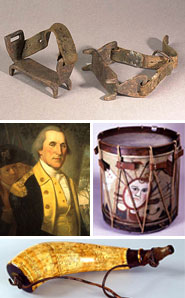|
- Verena Calas, National Park Service Museum Educator, Washington D.C
- 6-8 grades
- 5
[Back to top]
|
- This lesson unit plan draws on the extraordinary Valley Forge National Historic Park museum collections featured in the virtual museum exhibit at www.nps.gov/museum.
- Students will explore the challenges experienced by the Continental Army and its leadership, including General Washington, during their encampment at Valley Forge during the winter of 1777-1778 through object-based learning, hands-on activities, and active research. Students will work with and analyze primary source materials; including original Washington correspondence and other related documentation. Students will have the opportunity to make connections between the Revolutionary War period and the present by examining the similarities and differences between the original training manual of General Von Steuben and modern military manuals. Students will also practice analytical research, close reading, and debate skills through the examination of symbolism in colonial currency, the analysis of 18th century portraiture, and the discussion of women's role in the military.
- : During the American Revolution, General Washington and the fledgling Continental Army encountered many obstacles. However, from the Valley Forge encampment they emerge an organized and trained fighting force. Therefore, what obstacles did soldiers encounter while at Valley Forge? And, what factors contributed its emergence as a trained professional fighting force?
The following lesson plans are organized individually but make up a cohesive unit plan for "The Winter at Valley Forge". Teachers can choose to teach all five lessons as a unit, or each individually.
- This lesson introduces students to the challenges experienced by every day soldiers and their commanding officers during the winter at Valley Forge and explores how they dealt with these challenges not only physically, but mentally, as well.
- This lesson introduces students to the primary source documentation and analysis through the correspondence of men living in the Valley Forge encampment. Students will get another look into the challenges the camp presents as well as the emotional toll war can on the soldiers fighting it.
- This lesson explores the military training and tactics introduced by General Von Steuben at Valley Forge. Students will explore the importance of military manuals as modes of sharing information amongst large organized groups.
- This lesson explores the various rolls of women at the Valley Forge encampment. Students will compare the experiences of Valley Forge women to the changing rolls of American women in the military throughout history and partake in a class debate.
- This lesson explores the different kinds of currency and symbolism used not only in the Valley Forge Camp, but in the Thirteen Colonies at large. Students will also engage in the mathematical exchange of money.
[Back to top]
|
| This lesson introduces students to the challenges experienced by every day soldiers and their commanding officers during the winter at Valley Forge and explores how they dealt with these challenges not only physically, but mentally, as well. |
| MUSEUM OBJECT [photos of objects in the Parks museum collections] |
SIMILAR OBJECTS [local items similar to museum objects] & OTHER MATERIALS |
Length of time |
|
Activity 1: Who are the women of Valley Forge?
|
20 minutes |
|
|
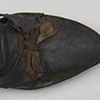 |
 |
Women's Shoes
|
Hatchel |
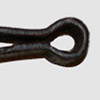 |
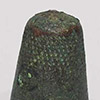
|
Tissue and Dressing Forceps
|
Thimble |
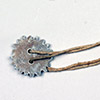 |
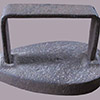
|
Buzzer
|
Pressing Iron |
|
|
|
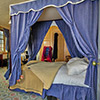 |
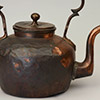
|
General and Mrs. Washington's Bedroom
|
Tea kettle
|
|
|
60
minutes |
|
Activity 3: Class Debate
- Stopwatch/timer
- Note cards (if needed)
- Journals/Notebooks
- Class Debate Guide (provided in supplementary documents)
|
50 minutes |
[Back to top]
|
Understands the impact of the American Revolution on politics, economy, and society
Analyze the relationship between a primary and secondary source on the same topic.
Cite specific textual evidence to support analysis of primary and secondary sources, attending to such features as the date and origin of the information.
Determine the central ideas or information of a primary or secondary source; provide an accurate summary of how key events or ideas develop over the course of the text.
Compare and contrast treatments of the same topic in several primary and secondary sources
[Back to top] |
- SWBAT describe the roles of different women within the Valley Forge encampment and the difficulties they faced.
- SWBAT make connections between the women at Valley Forge and the changing role of women in the U.S. war effort and armed services.
- SWBAT research original content in preparation for a debate.
- SWBAT create an argument with supporting evidence around a debate topic.
[Back to top]
|
The Winter at Valley Forge: Background Information PowerPoint (slide 16)
Valley Forge National Historic Park Website: The Women Present at Valley Forge
[Back to top]
|
Affirmative: agreeing with a statement or request.
Negative: a word or statement that expresses disagreement.
Opening Statements: a paragraph outlining the main points of reasoning for your argument to be presented at the beginning of the debate.
Closing Statements: a paragraph summarizing the main points of reasoning for your argument to be presented at the end of the debate.
Individual Arguments: each person on the team must speak at least ONCE and present original evidence to support your team’s argument.
|
|
-
Split lesson into multiple days for different phases of research of and debate.
- Create more debate topics surrounding women and the military for smaller group debates depending on class size.
[Back to top] |
[Back to top]
|
|
Other Materials Listed in Sections C
|
- Visit the Valley Forge National Historic Park Virtual Exhibition
- Visit the Valley Forge National Historic Park Website
|

